Battlefield Tour April 2014
Arthur Graeme West (SH 1905-10) wrote this poem while fighting in the trenches:
‘God! How I Hate You, You Young Cheerful Men!'
Captain A.G. West, 6th Battalion Oxford & Bucks Light Infantry. Died 3rd April 1917 aged 25, one of the celebrated Great War Poets.
On Sunday morning the Blundell's Battlefield Pilgrimage visited the HAC CWGC where Arthur Graeme West is buried. Tim Courtenay placed a remembrance cross at his graveside and then read out aloud West's poem.
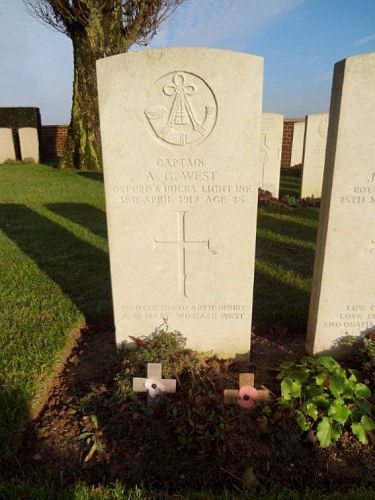
The Grave of A.G. West with a Blundellian Cross
'In Flanders Fields' by John McCrae 1915
'In Flanders Fields' is a war poem in the form of a rondeau, written during the First World War by Canadian physician Lieutenant Colonel John McCrae. He was inspired to write it on May 3, 1915, after presiding over the funeral of friend and fellow soldier Alexis Helmer, who died in the Second Battle of Ypres.
According to legend, fellow soldiers retrieved the poem after McCrae, initially unsatisfied with his work, discarded it. 'In Flanders Fields' was first published on December 8 of that year in the London-based magazine Punch.
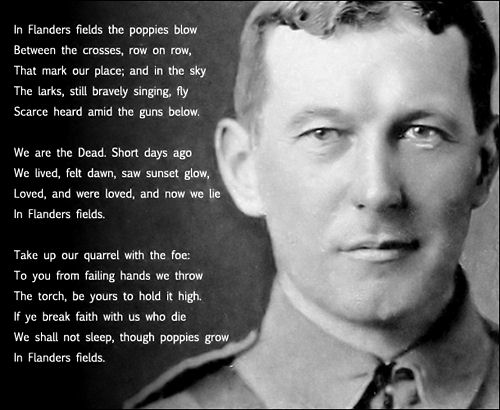
"In Flanders Fields" by John McCrae, 1915
'Some Mother's Son'
Like so many before me, I was struck by the futility of it all, and by the loss of so many men who were each “Some Mother’s Son”
‘White tombstonges by the thousands from every race on earth,
And every one is for a son some Mother brought to birth.
Beneath the Cross of Scrifice and the Great Crusader’s Sword
Some stones have names engraved thereon, their memory secured.
But other graves hold unknown bones, “A Soldier known to God”;
You lie in serried ranks in death as you rest beneath the sod.
You did not start this dreadful war, but you chose to face the gun.
We may not know your name, my friend, but you were some Mother’s son.’
Charlie Abram (M 1959-64) remembering Evan Cameron at the Menin Gate
Charlie Abram had more connections with Evan Cameron than merely the Blundell’s connections. E.S. Cameron had had as distinguished a career in the very early years of the last century at that most famous of Devon Prep Schools St. Peter's, as he had had at Blundell's afterwards.
For many years, much later on, Charlie & Di Abram were to be Headmaster and 'HMW' respectively at St. Peter's School.
Charlie placed a Remembrance Cross beside Evan Cameron's name, amongst the many panels of Canadian regiments remembered at the Menin Gate at Ypres. Before leaving the Canadian panels to meet our group at the Menin Gate for the Last Post Ceremony, Charlie was photographed and interviewed by two journalists from the 'Toronto Star', Richard Lautens and Katie Daubs.
Lautens and Daubs are reporting on their own four month walk along the 'Western Front', so no doubt the tale of how Charlie came to remember fellow Blundellian Corporal Evan Cameron of the Quebec Regiment will be being told shortly in the 'Toronto Star'.
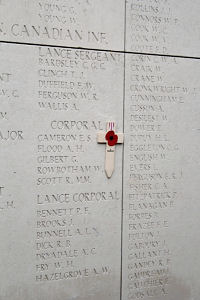
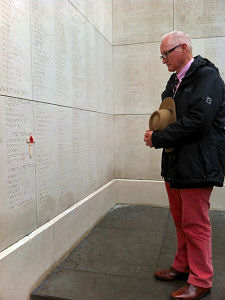
A memorial Cross to commemorate Corporal E.S. Cameron
Bisley Team 1910. Whatever happened to 'Joey Thornton's Boys'?
At about the time of this terrible slaughter of these Blundellians, Mr. A.L. Francis the Headmaster drawing to the close of his 43 year headship, wrote a letter to the Times on 20th July 1915:
“I wonder how many men holding mathematical and science scholarships at Oxford and Cambridge are being wasted, so far as their special gifts are concerned, as subalterns in service battalions of line regiments. I know of at least three young officers of exceptional mathematical ability who are being or will shortly be so misemployed. We should be thrifty of such men, not only for special branches of the Services, but also in view of our needs after the war."
Were the three Cambridge maths scholars to whom Mr. Francis referred, Philip Marrack, Archibald Hill, and Percival Walsh? All three were Mathematical Scholars and Wranglers at Cambridge, and all protégés of Mr. 'Joey' Thornton (Mathematics Master 1884-1916), the first in a long line of iconic Blundell's maths masters, a line unbroken to the present day.
In 1916, during his final year Thornton was to hear of the deaths of another three of his most distinguished pupils in battle - Lothair Stevens, a Balliol Scholar, and Alan Baillie and Louis Rees-Mogg, who had both won Sidney Sussex Scholarships. Might it have been these three 'Joey Thornton Boys' to whom the Headmaster had been referring in his letter to the Times in 1915?
Thornton was spared the news of the death of Percival Walsh the 'Joey Thornton Boy' mentioned earlier who had been such a star at Blundell's. Walsh had been a Monitor, a member of the Blundell's Bisley VIII, seated on the extreme right of the photo of that team included at page 10 of our Battlefield Tour programme. Percival Walsh was also in the Blundell's 1st XV, before winning a Mathematics Scholarship to Trinity College Cambridge.
Percival Walsh had soon joined the North Lancashire Regiment. When the Headmaster A.L. Francis wrote to Archibald Hill, also a 'Joey Thornton Boy' of course, informing him of Thornton's death, he added that it would be hard to find a replacement, ' but my fancy goes to Walsh, if he would come, and if he is spared this ghastly slaughter'. It was not to be.
Instead, to take Thornton's place, Francis chose Arthur Wynne to be Head of Mathematics in July 1916. A big 'what if?' of Blundell's history is what would have happened if the 'Joey Thornton Boy' Percival Walsh of the North Lancashire Regiment had been spared? Would Walsh have taken Thornton's place and Wynne never have come to the School? When Francis retired in 1917 who, without the arrival of Wynne the year before, would then have become Headmaster in 1917?
'Joey Thornton Boys' Archibald Hill, of the Cambridgeshire Regiment, and Morris Travers were pulled from the fighting. Hill was asked to develop an anti-aircraft experimental section in the munitions inventions department. Morris Travers assisted the War Office in developing a factory for the filling of hand grenades with poison liquid.
Archibald Hill went on to be awarded the Nobel Prize for Physiology or Medicine in 1922.
Morris Travers co-discovered 3 of the inert gases neon, krypton, and xenon, dying in 1961, the same year another 'Joey Thornton Boy' George May died. May of 'Mayfield' fame had endowed a 'Thornton Scholarship' at Blundell's in 1912 and in 1920 gave generously to the School's War Memorial Fund.
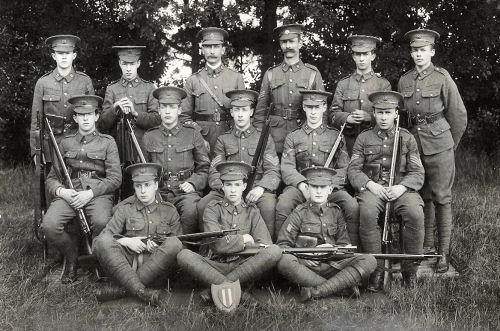
The 1910 Shooting Team - six of these OBs were killed
BACK ROW: W.N. Spicer (SH); G.M. Paddison (DB); Capt. E.G. Peirce; Col. Sergt. Inst. Ayres; D.H. McCririck (P); H.C.C. Lloyd (W)
MIDDLE ROW: G.L. Appleton (OH); F.S. Thompson (SH); R.H. Paddison (DB); M.W.M. Windle (P); W. Bastard (NC)
FRONT ROW: R.H.F. Duckworth (P); J. Carew (SH); C.P. Gordon (NC)
Of the above G. Paddison, H.C.C. Lloyd, M.W.M. Windle, W. Bastard, J. Carew and C.P. Gordon were all killed during the War, and W.N. Spicer, and R.H.F. Duckworth were wounded
Lieutenant Edward Bellew, VC
Saturday afternoon 26th April we went to Vancouver Corner and the great Canadian Memorial, close by the site of the action by Lieutenant Edward Bellew where he won his Victoria Cross in April 1915 during the first German gas attack on the Ypres Salient.
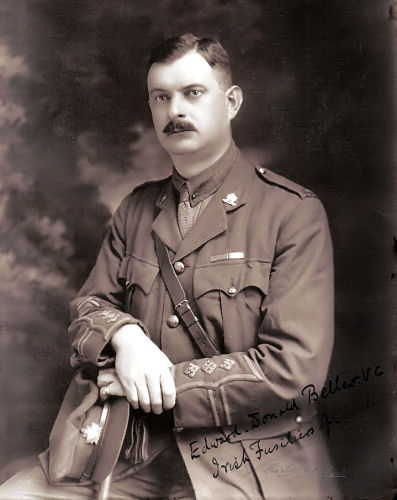

Lt Edward Bellew and the Victoria Cross
The citation for Edward Bellew's Victoria Cross read:
‘For most conspicuous bravery and devotion to duty near Keerselaere on April 24th 1915, during the German attack on the Ypres salient. Captain (then Lieutenant) Bellew, as Battalion Machine Gun Officer, had two guns in action on the high ground overlooking Keerselaere. The enemy's attack broke in full force on the morning of the 24th against the front and right flank of the Battalion - the latter being exposed owing to a gap in the line. The right Company was soon put out of action, but the advance was temporarily stayed by Captain Bellew, who had sited his guns on the left of the right Company. Reinforcements were sent forward but they in turn were surrounded and destroyed. With the enemy in strength less than 100 yards from him, with no further assistance in sight, and with his rear threatened, Captain Bellew and Sergeant Peerless, each operating a gun, decided to stay where they were and fight it out. Sergeant Peerless was killed and Captain Bellew was wounded and fell. Nevertheless, he got up and maintained his fire till ammunition failed and the enemy rushed the position. Captain Bellew then seized a rifle, smashed his machine gun, and fighting to the last, and was taken prisoner.'
Acts of selfless heroism were often recorded in the Blundellian, Edward Bellew's was no exception. In the July, Blundellian of 1915 is printed Sir John French's dispatch of the Second Battle of Ypres, in which he said,
'One machine gun officer, Lieutenant Bellew, with a defiant loaf stuck on his bayonet point above the parapet, fought his machine gun till it was smashed to pieces, and then continued the struggle with relays of rifles'.